CoMnO2-Decorated Polyimide-Based Carbon Fiber Electrodes for Wire-Type Asymmetric Supercapacitor Applications
Abstract
1. Introduction
2. Results and Discussion
3. Materials and Methods
3.1. Materials
3.2. Fabrication of Transition Metal Oxides-Coated PICF Electrodes
3.3. Electrodeposition of Ni Seed Layer on PICF
3.4. Characterization
3.5. Electrochemical Measurements
4. Conclusions
Supplementary Materials
Author Contributions
Funding
Conflicts of Interest
References
- Wang, L.; Menakath, A.; Han, F.; Wang, Y.; Zavalij, P.Y.; Gaskell, K.J.; Borodin, O.; Iuga, D.; Brown, S.P.; Wang, C.; et al. Identifying the components of the solid-electrolyte interphase in Li-ion batteries. Nat. Chem. 2019, 11, 789–796. [Google Scholar] [CrossRef] [PubMed]
- Zhai, S.; Karahan, H.E.; Wang, C.; Pei, Z.; Wei, L.; Chen, Y. 1D supercapacitors for emerging electronics: Current status and future directions. Adv. Mater. 2020, 32, 1902387–1902405. [Google Scholar] [CrossRef] [PubMed]
- Yaghtin, A.; Masoudpanah, S.M.; Hasheminiasari, M.; Salehi, A.; Safanama, D.; Ong, C.K.; Adams, S.; Reddy, M.V. Effect of reducing agent on solution synthesis of Li3V2(PO4)3 cathode material for lithium ion batteries. Molecules 2020, 25, 3746. [Google Scholar] [CrossRef] [PubMed]
- Zhou, K.; Zhou, W.; Yang, L.; Lu, J.; Cheng, S.; Mai, W.; Tang, Z.; Li, L.; Chen, S. Ultrahigh-performance pseudocapacitor electrodes based on transition metal phosphide nanosheets array via phosphorization: A general and effective approach. Adv. Funct. Mater. 2015, 25, 7530–7538. [Google Scholar] [CrossRef]
- Vijayan, B.L.; Zain, N.K.M.; Misnon, I.I.; Reddy, M.V.; Adams, S.; Yang, C.C.; Anilkumar, G.M.; Jose, R. Void space control in porous carbon for high-density supercapacitive charge storage. Energy Fuels 2020, 34, 5072–5083. [Google Scholar] [CrossRef]
- Tang, X.; Jia, R.; Zhai, T.; Xia, H. Hierarchical Fe3O4@Fe2O3 core-shell nanorod arrays as high-performance anodes for asymmetric supercapacitors. ACS. Appl. Mater. Int. 2015, 7, 27518–27525. [Google Scholar] [CrossRef]
- Harilal, M.; Krishnan, S.G.; Vijayan, B.L.; Reddy, M.V.; Adams, S.; Barron, A.R.; Yusoff, M.M.; Jose, R. Continuous nanobelts of nickel oxide-cobalt oxide hybrid with improved capacitive charge storage properties. Mat. Des. 2017, 122, 376–384. [Google Scholar] [CrossRef]
- Chodankar, N.R.; Dubal, D.P.; Ji, S.H.; Kim, D.H. Self-assembled nickel pyrophosphate-decorated amorphous bimetal hydroxides 2D-on-2D nanostructure for high-energy solid state asymmetric supercapacitor. Small 2019, 15, 1901145–19001155. [Google Scholar] [CrossRef]
- Patil, A.M.; Lokhande, A.C.; Chodankar, N.R.; Shinde, P.A.; Kim, J.H.; Lokhande, C.D. Interior design engineering of CuS architecture alteration with rise in reaction bath temperature for high performance symmetric flexible solid state supercapacitor. J. Ind. Eng. Chem. 2017, 46, 91–102. [Google Scholar] [CrossRef]
- Meng, F.; Li, Q.; Zheng, L. Flexible fiber-shaped supercapacitors: Design, fabrication, and multi-functionalities. Energy Storage Mater. 2017, 8, 85–109. [Google Scholar] [CrossRef]
- Hu, M.; Liu, Y.; Zhang, M.; Wei, H.; Gao, Y. Wire-type MnO2/Multilayer graphene/Ni electrode for high-performance supercapacitor. J. Power Sources 2016, 335, 113–120. [Google Scholar] [CrossRef]
- Yang, Z.; Deng, J.; Chen, X.; Ren, J.; Peng, H. A highly stretchable, fiber-shaped supercapacitor. Angew. Chem. Int. Ed. 2013, 52, 13453. [Google Scholar] [CrossRef] [PubMed]
- Nwanya, A.C.; Jafta, C.J.; Ejikeme, P.M.; Ugwuoke, P.E.; Reddy, M.V.; Osuji, R.U.; Ozoemena, K.I.; Ezema, F.I. Electrochromic and electrochemical capacitive properties of tungsten oxide and its polyaniline nanocomposite films obtained by chemical bath deposition method. Electrochim. Acta 2014, 128, 218–225. [Google Scholar] [CrossRef]
- Liu, N.; Ma, W.; Tao, J.; Zhang, X.; Su, J.; Li, L.; Yang, C.; Gao, Y.; Golberg, D.; Bando, Y. Cable-type supercapacitors of three-dimensional cotton thread based multi-grade nanostructures for wearable energy storage. Adv. Mater. 2013, 25, 4925–4931. [Google Scholar] [CrossRef] [PubMed]
- Zhai, T.; Xie, S.; Yu, M.; Fang, P.; Liang, C.; Lu, X.; Tong, Y. Oxygen vacancies enhancing capacitive properties of MnO2 nanorods for wearable asymmetric supercapacitors. Nano Energy 2014, 8, 255–263. [Google Scholar] [CrossRef]
- Ko, T.H.; Lei, D.; Balasubramaniam, S.; Seo, M.K.; Chung, Y.S.; Kim, H.Y.; Kim, B.S. Polypyrrole-decorated hierarchical NiCo2O4 nanoneedles/carbon fiber papers for flexible high-performance supercapacitor applications. Electrochim. Acta 2017, 247, 524–534. [Google Scholar] [CrossRef]
- Jayaseelan, S.S.; Ko, T.H.; Radhakrishnan, S.; Yang, C.M.; Kim, H.Y.; Kim, B.S. Novel MWCNT interconnected NiCo2O4 aerogels prepared by a supercritical Co2 drying method for ethanol electrooxidation in alkaline media. Int. J. Hydrogen Energy 2016, 41, 13504–13512. [Google Scholar] [CrossRef]
- Wang, K.; Meng, Q.; Zhang, Y.; Wei, Z.; Miao, M. High-performance two-ply yarn supercapacitors based on carbon nanotubes and polyaniline nanowire arrays. Adv. Mater. 2013, 25, 1494–1498. [Google Scholar] [CrossRef]
- Meng, Y.; Zhao, Y.; Hu, C.; Cheng, H.; Hu, Y.; Zhang, Z.; Shi, G.; Qu, L. All-graphene core-sheath microfibers for all-solid-state, stretchable fibriform supercapacitors and wearable electronic textiles. Adv. Mater. 2013, 25, 2326–2331. [Google Scholar] [CrossRef]
- Li, X.; Zang, X.; Li, Z.; Li, X.; Li, P.; Sun, P.; Lee, X.; Zhang, R.; Huang, Z.; Wang, K.; et al. Large-area flexible core-shell graphene/porous carbon woven fabric films for fiber supercapacitor electrodes. Adv. Funct. Mater. 2013, 23, 4862–4869. [Google Scholar] [CrossRef]
- Saravanakumar, B.; Ko, T.H.; Kim, B.S. Rational design of binder-free ZnCo2O4 and Fe2O3 decorated porous 3D Ni as high-performance electrodes for asymmetric supercapacitor. Ceram. Int. 2018, 44, 10635–10645. [Google Scholar] [CrossRef]
- Yuan, D.; Li, B.; Cheng, J.; Guan, Q.; Wang, Z.; Ni, W.; Li, C.; Liu, H.; Wang, B. Twisted yarns for fiber-shaped supercapacitors based on wetspun PEDOT:PSS fibers from aqueous coagulation. J. Mater. Chem. A 2016, 4, 11616–11624. [Google Scholar] [CrossRef]
- Cheng, X.; Zhang, J.; Ren, J.; Liu, N.; Chen, P.; Zhang, Y.; Deng, J.; Wang, Y.; Peng, H. Design of a hierarchical ternary hybrid for a fiber-shaped asymmetric supercapacitor with high volumetric energy density. J. Phys. Chem. C 2016, 120, 9685–9691. [Google Scholar] [CrossRef]
- Ramadoss, A.; Kang, K.N.; Ahn, H.J.; Kim, S.I.; Ryu, S.T.; Jang, J.H. Realization of high performance flexible wire supercapacitors based on 3-dimensional NiCo2O4/Ni fibers. J. Mater. Chem. A 2016, 4, 4718–4727. [Google Scholar] [CrossRef]
- Tao, J.; Liu, N.; Ma, W.; Ding, L.; Li, L.; Su, J.; Gao, Y. Solid-state high performance flexible supercapacitors based on polypyrrole-MnO2-carbon fiber hybrid structure. Sci. Rep. 2013, 3, 2286–2292. [Google Scholar] [CrossRef]
- Ko, T.H.; Radhakrishnan, S.; Seo, M.K.; Khil, M.S.; Kim, H.Y.; Kim, B.S. A green and scalable dry synthesis of NiCo2O4/graphene nanohybrids for high-performance supercapacitor and enzymeless glucose biosensor applications. J. Alloys Compd. 2017, 696, 193–200. [Google Scholar] [CrossRef]
- Dong, X.; Jin, H.; Wang, R.; Zhang, J.; Feng, X.; Yan, C.; Chen, S.; Wang, S.; Wang, J.; Lu, J. High Volumetric Capacitance, Ultralong Life Supercapacitors Enabled by Waxberry-Derived Hierarchical Porous Carbon Materials. Adv. Energy Mater. 2018, 8, 1702695. [Google Scholar] [CrossRef]
- Saravanakumar, B.; Jayseelan, S.S.; Seo, M.K.; Kim, H.Y.; Kim, B.S. NiCo2S4 nanosheet-decorated 3D, porous Ni film@Ni wire electrode materials for all solid-state asymmetric supercapacitor applications. Nanoscale 2017, 9, 18819. [Google Scholar] [CrossRef]
- Xu, Z.; Sun, S.; Cui, W.; Lv, J.; Geng, Y.; Li, H.; Deng, J. Interconnected network of ultrafine MnO2 nanowires on carbon cloth with weed-like morphology for high-performance supercapacitor electrodes. Electrochim. Acta 2018, 268, 340–346. [Google Scholar] [CrossRef]
- Huang, J.; Chen, L.; Dong, H.; Zeng, Y.; Hu, H.; Zheng, M.; Liu, Y.; Xiao, Y.; Liang, Y. Hierarchical porous carbon with network morphology derived from natural leaf for superior aqueous symmetrical supercapacitors. Electrochim. Acta 2017, 258, 504–511. [Google Scholar] [CrossRef]
- Pan, C.; Gu, H.; Dong, L. Synthesis and electrochemcial performance of polyaniline@MnO2/graphene ternary composites for electrochemical supercapacitors. J. Power Sources 2016, 303, 175–181. [Google Scholar] [CrossRef]
- Zhao, Z.; Shen, T.; Liu, Z.; Zhong, Q.; Qin, Y. Facile fabrication of binder-free reduced graphene oxide/MnO2/Ni foam hybrid electrode for high-performance supercapacitors. J. Alloys Comp. 2020, 812, 152124–152132. [Google Scholar] [CrossRef]
- Wu, M.S.; Chen, F.Y.; Lai, Y.H.; Sie, Y.J. Electrocatalytic oxidation of urea in alkaline solution using nickel/nickel oxide nanoparticles derived from nickel-organic framework. Electrochim. Acta 2017, 258, 167–174. [Google Scholar] [CrossRef]
- Peng, H.H.; Chen, J.; Jiang, D.Y.; Li, M.; Feng, L.; Losic, D.; Dong, F.; Zhang, Y.X. Synergistic effect of manganese dioxide and diatomite for fast decolorization and high removal capacity of methyl orange. J. Colloid Interf. Sci. 2016, 484, 1–9. [Google Scholar] [CrossRef] [PubMed]
- Xiao, A.; Zhou, S.; Zuo, C.; Zhuan, Y.; Ding, X. Controllable synthesis of mesoporous Co3O4 nanoflake array and its application for supercapacitor. Mater. Res. Bull. 2014, 60, 674–678. [Google Scholar] [CrossRef]
- Sun, X.; Xu, T.; Bai, J.; Li, C. MnO2 Nanosheets Grown on Multichannel Carbon Nanofibers Containing Amorphous Cobalt Oxide as a Flexible Electrode for Supercapacitors. ACS Appl. Energy Mater. 2019, 2, 8675–8684. [Google Scholar] [CrossRef]
- Zhao, J.; Li, Z.; Yuan, X.; Yang, Z.; Zhang, M.; Meng, A.; Li, Q. A High-Energy Density Asymmetric Supercapacitor Based on Fe2O3 Nanoneedle Arrays and NiCo2O4/Ni(OH)2 Hybrid Nanosheet Arrays Grown on SiC Nanowire Networks as Free-Standing Advanced Electrodes. Adv. Energy Mater. 2018, 8, 1702787. [Google Scholar] [CrossRef]
- Wang, X.; Liu, Y.; Arandiyan, H.; Yang, H.; Bai, L.; Mujtaba, J.; Wang, Q.; Liu, S.; Sun, H. Uniform Fe3O4 microflowers hierarchical structures assembled with porous nanoplates as superior anode materials for lithium-ion batteries. Appl. Surf. Sci. 2016, 389, 240–246. [Google Scholar] [CrossRef]
- Cho, Y.H.; Ko, T.H.; Choi, W.K.; Kuk, Y.S.; Seo, M.K.; Kim, B.S. Micro-flower NiCoMnO2 superstructures prepared by a catalytic chemical oxidation for supercapacitor applications. Tex. Sci. Eng. 2020, 57, 306–314. [Google Scholar]
- Oyedotun, K.O.; Masikhwa, T.M.; Mirghni, A.A.; Mutuma, B.K.; Manyala, N. Electrochemical properties of asymmetric supercapacitor based on optimized carbon-based nickel-cobalt-manganese ternary hydroxide and sulphur-doped carbonized iron-polyaniline electrodes. Electrochim. Acta 2020, 334, 135610. [Google Scholar] [CrossRef]
- Du, Y.; Li, G.; Chen, M.; Yang, X.; Ye, L.; Liu, X.; Zhao, L. Hollow nickel-cobalt-manganese hydroxide polyhedra via MOF templates for high-performance quasi-solid-state supercapacitor. Chem. Eng. J. 2019, 378, 122210. [Google Scholar] [CrossRef]
- Bai, X.; Cao, D.; Zhang, H. Simultaneously morphology and phase controlled synthesis of cobalt manganese hydroxides/reduced graphene oxide for high performance supercapacitor electrodes. Ceram. Int. 2020, 46, 19135–19145. [Google Scholar] [CrossRef]
- Guo, Y.; Zhang, S.; Wang, J.; Liu, Z.; Liu, Y. Facile preparation of high-performance cobalt-manganese layered double hydroxide/polypyrrole composite for battery-type asymmetric supercapacitors. J. Alloys Comp. 2020, 832, 154899–154911. [Google Scholar] [CrossRef]
- Nath, A.R.; Jayachandran, A.; Sandhyarani, N. Nanosheets of nickel, cobalt and manganese triple hydroxides/oxyhydroxides as efficient electrode materials for asymmetrical supercapacitors. Dalton Trans. 2019, 48, 4211–4217. [Google Scholar] [CrossRef]
- Li, M.; Cheng, J.P.; Wang, J.; Liu, F.; Zhang, X.B. The growth of nickel-manganese and cobalt-manganes layered double hydroxides on reduced graphene oxide for supercapacitor. Electrochim. Acta 2016, 206, 108–115. [Google Scholar] [CrossRef]
- Wenping, Y.; Xinyue, S.; Yan, L.; Pang, H. Manganese-doped cobalt zeolitic imidazolate framework with highly enhanced performance for supercapacitor. J. Energy Storage 2019, 26, 101018–101024. [Google Scholar]
- Kim, N.K.; Kim, W.S.; Jang, H.J.; Chung, Y.S. Fabrication and properties of polyimide-based graphite fibers. Tex. Sci. Eng. 2020, 56, 300–307. [Google Scholar]

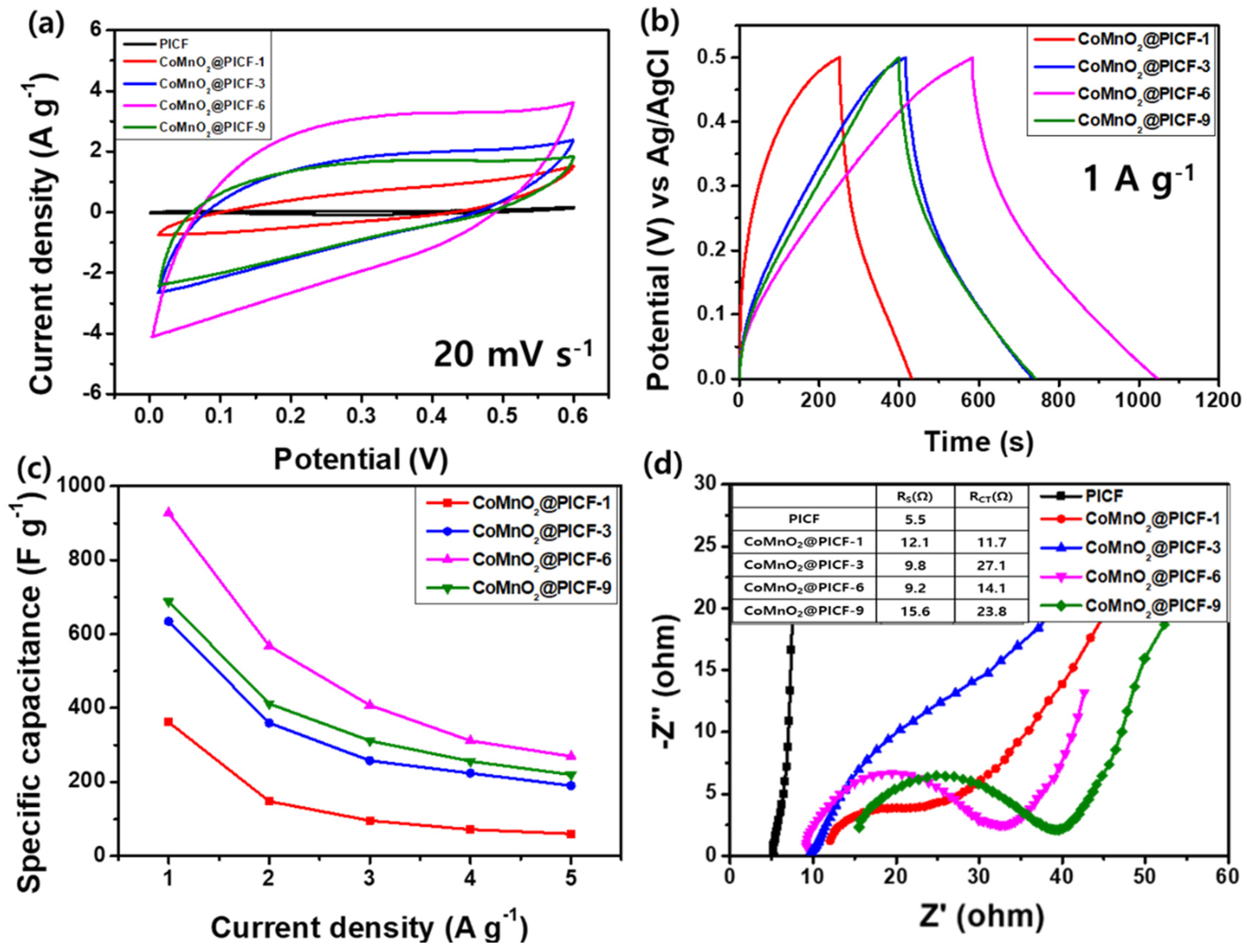
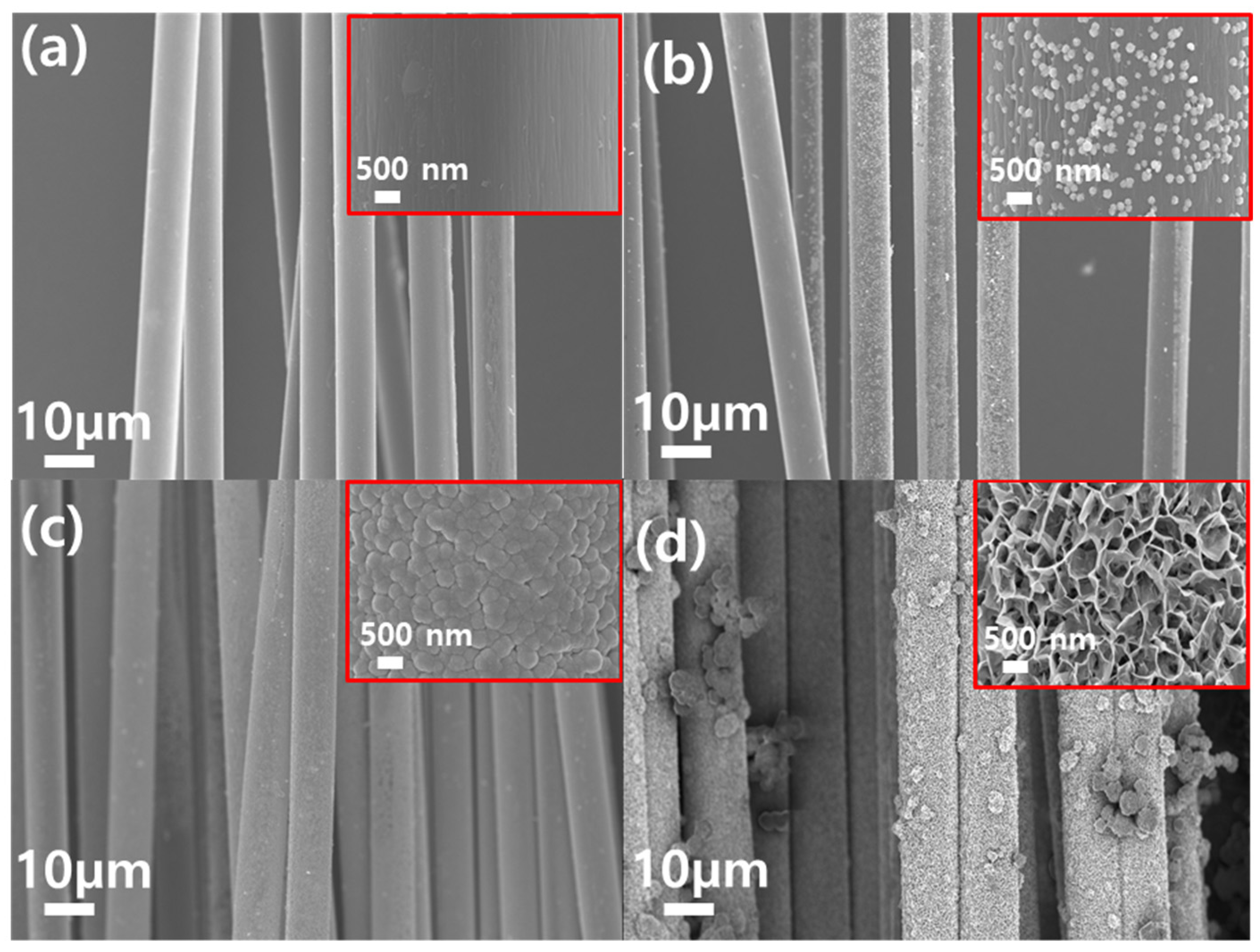
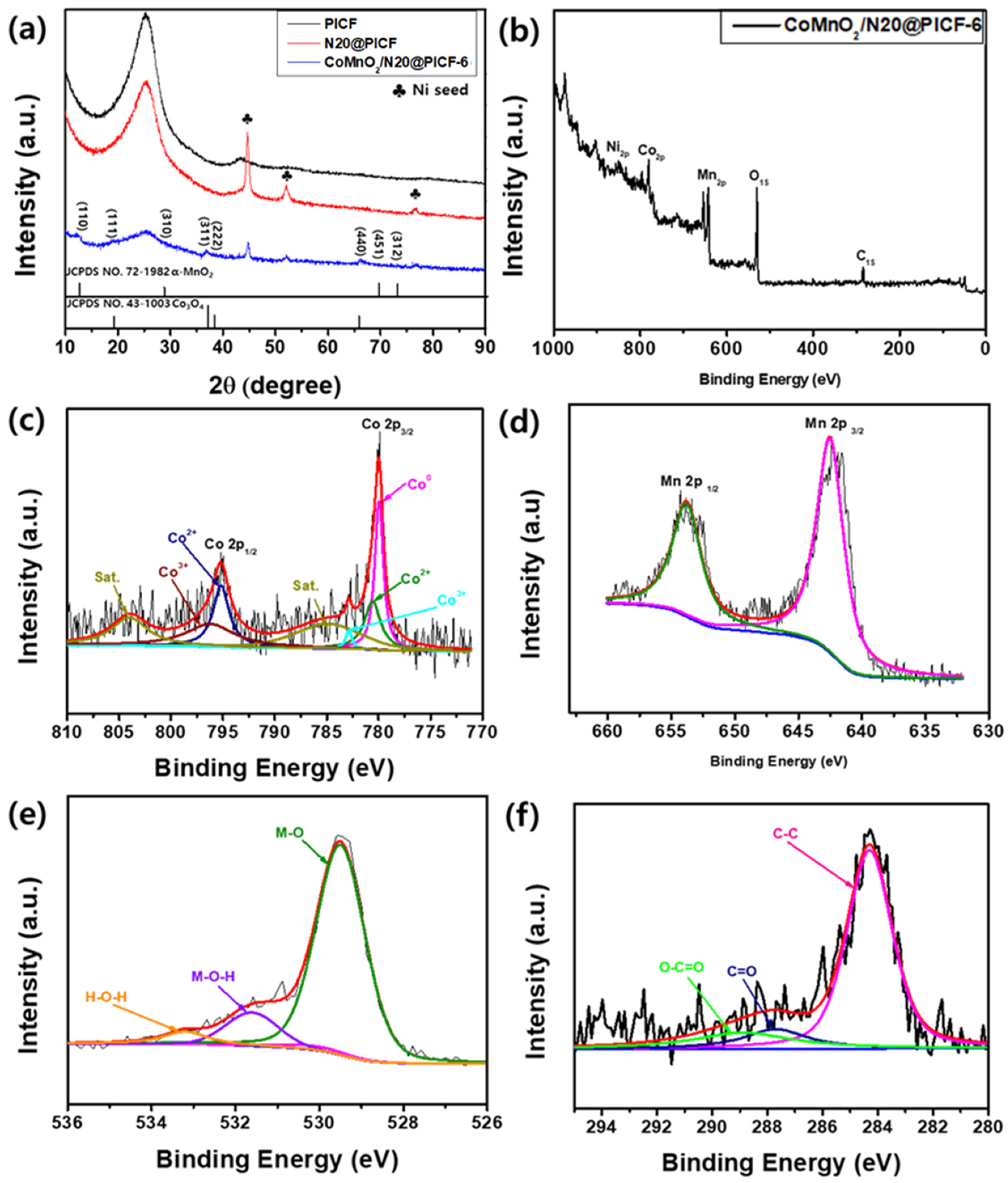
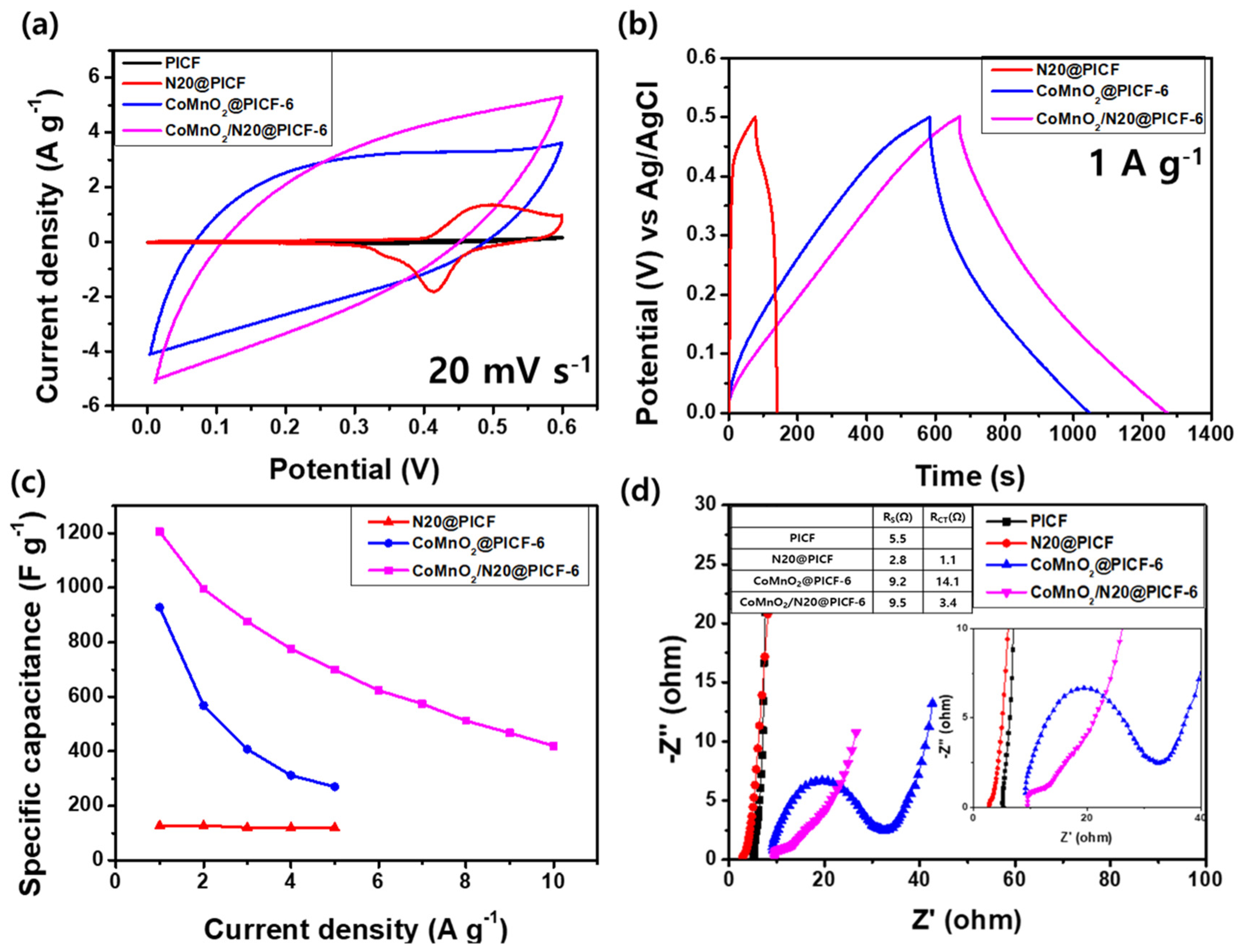
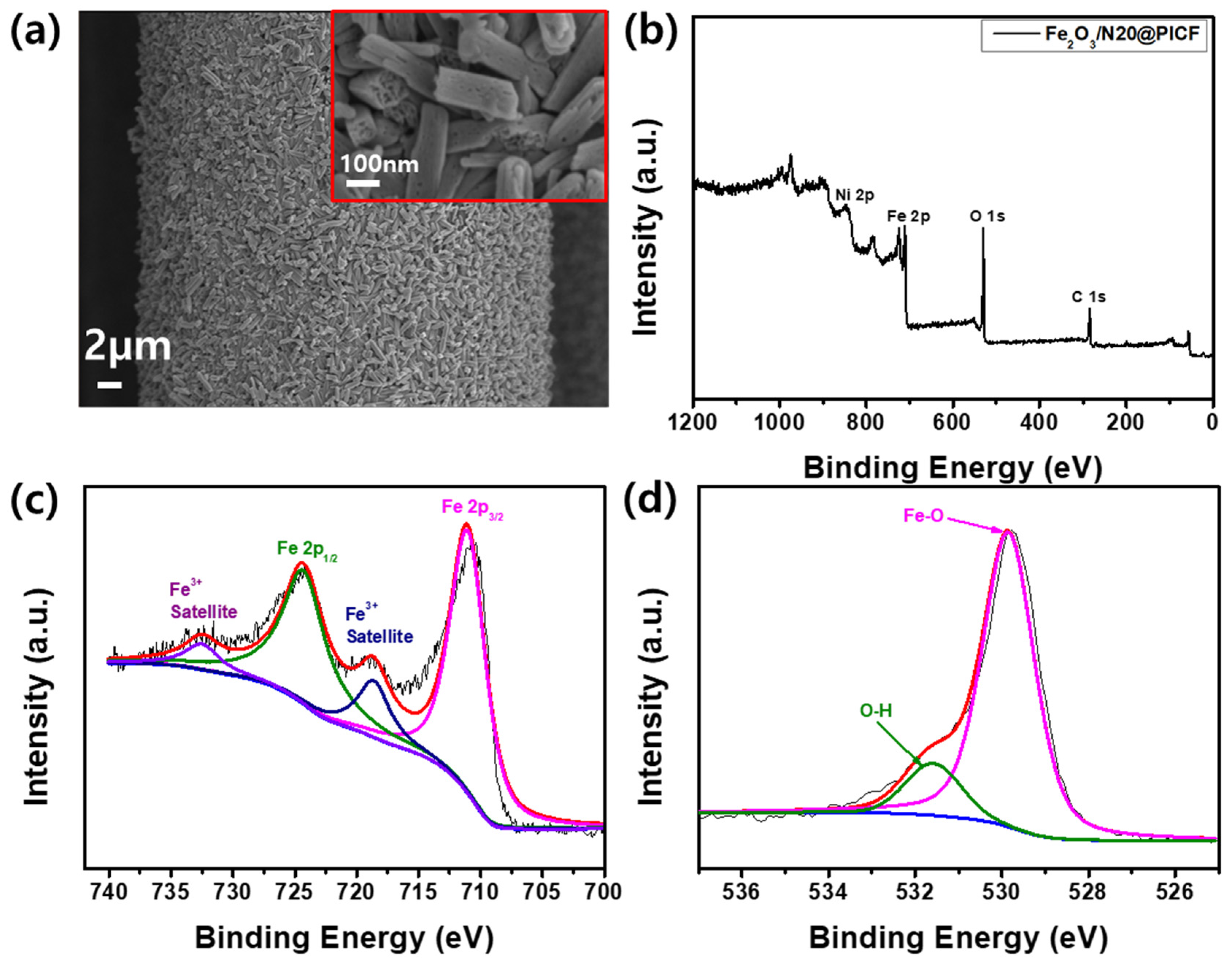

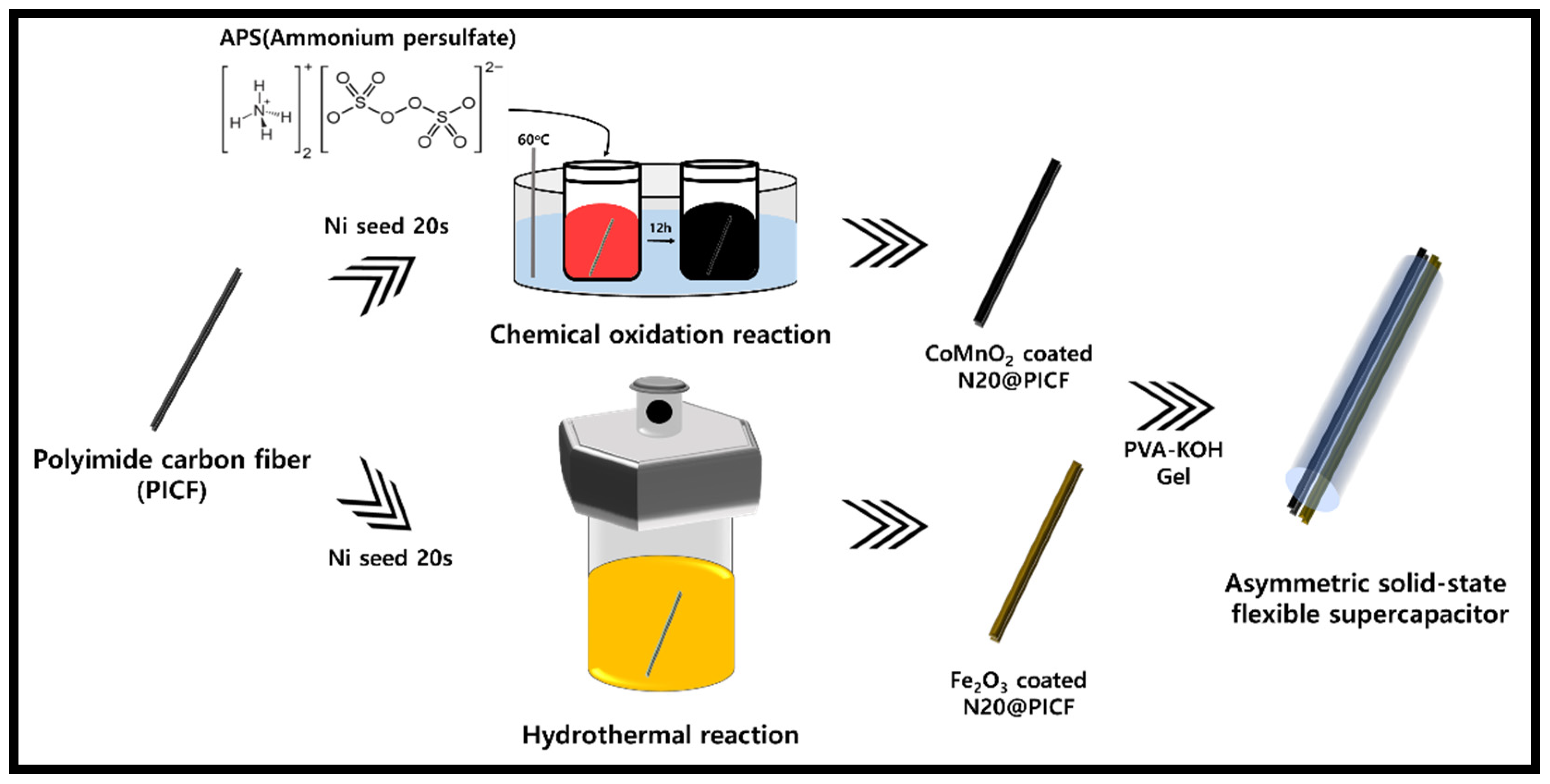
Sample Availability: Not available. | |
Publisher’s Note: MDPI stays neutral with regard to jurisdictional claims in published maps and institutional affiliations. |
© 2020 by the authors. Licensee MDPI, Basel, Switzerland. This article is an open access article distributed under the terms and conditions of the Creative Commons Attribution (CC BY) license (http://creativecommons.org/licenses/by/4.0/).
Share and Cite
Cho, Y.-H.; Seong, J.-G.; Noh, J.-H.; Kim, D.-Y.; Chung, Y.-S.; Ko, T.H.; Kim, B.-S. CoMnO2-Decorated Polyimide-Based Carbon Fiber Electrodes for Wire-Type Asymmetric Supercapacitor Applications. Molecules 2020, 25, 5863. https://doi.org/10.3390/molecules25245863
Cho Y-H, Seong J-G, Noh J-H, Kim D-Y, Chung Y-S, Ko TH, Kim B-S. CoMnO2-Decorated Polyimide-Based Carbon Fiber Electrodes for Wire-Type Asymmetric Supercapacitor Applications. Molecules. 2020; 25(24):5863. https://doi.org/10.3390/molecules25245863
Chicago/Turabian StyleCho, Young-Hun, Jae-Gyoung Seong, Jae-Hyun Noh, Da-Young Kim, Yong-Sik Chung, Tae Hoon Ko, and Byoung-Suhk Kim. 2020. "CoMnO2-Decorated Polyimide-Based Carbon Fiber Electrodes for Wire-Type Asymmetric Supercapacitor Applications" Molecules 25, no. 24: 5863. https://doi.org/10.3390/molecules25245863
APA StyleCho, Y.-H., Seong, J.-G., Noh, J.-H., Kim, D.-Y., Chung, Y.-S., Ko, T. H., & Kim, B.-S. (2020). CoMnO2-Decorated Polyimide-Based Carbon Fiber Electrodes for Wire-Type Asymmetric Supercapacitor Applications. Molecules, 25(24), 5863. https://doi.org/10.3390/molecules25245863






